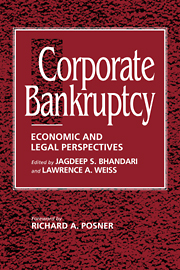Book contents
- Frontmatter
- Contents
- List of tables and figures
- Foreword by the HONORABLE RICHARD A. POSNER
- Preface
- Part I The role of credit
- Part II Bankruptcy as a reflection of the creditors' implicit bargain
- Part III Beyond the basic creditors' bargain
- Part IV Workouts or bargaining in the shadow of bankruptcy
- Part V Alternatives to bankruptcy and the creditors' bargain
- Part VI Experience of other countries
- Index
Part II - Bankruptcy as a reflection of the creditors' implicit bargain
Published online by Cambridge University Press: 10 December 2009
- Frontmatter
- Contents
- List of tables and figures
- Foreword by the HONORABLE RICHARD A. POSNER
- Preface
- Part I The role of credit
- Part II Bankruptcy as a reflection of the creditors' implicit bargain
- Part III Beyond the basic creditors' bargain
- Part IV Workouts or bargaining in the shadow of bankruptcy
- Part V Alternatives to bankruptcy and the creditors' bargain
- Part VI Experience of other countries
- Index
Summary
The chapters included in Part I explain why some firms include debt in their capital structures and others prefer to have debt with heterogeneous levels of priority. The chapters in this part explain the problems debt financing creates and the role of bankruptcy law in addressing those problems.
To understand the problems created by debt financing, imagine a firm that manufactures copper wire at a time when technology dictates that fiber optics will replace most uses of copper wire. The advent of fiber optics makes obsolete much of the manufacturers equipment and requires that the manufacturer substantially retool if it is to stay in business.
This obsolescence and the prospect of retooling significantly reduces the value of the firm compared to its value prior to the introduction of new technology. Such a reduction in value would not precipitate a financial crisis if the firm were financed purely by equity. The equity owners directly or through the firm managers acting as equity agents would simply assess the viability of the firm in the new world of fiber optics. The shareholders or their agents would then decide whether to continue the firm or to wind it up. If the firm continued, it would use existing capital or raise new capital to retool. If the firm wound up, it would liquidate and divide its assets ratably among the shareholders. In either case, the process could be orderly.
- Type
- Chapter
- Information
- Corporate BankruptcyEconomic and Legal Perspectives, pp. 25 - 28Publisher: Cambridge University PressPrint publication year: 1996



